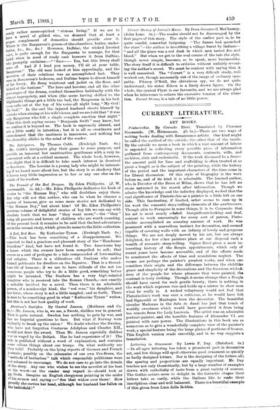C URRENT LITERATURE.
ART BOOKS.
Pintoricchio. By Corrado Ricci. Translated by Florence Simmonds. (W. Heinemann. .E5 5s.)—There are two ways of writing books dealing with Renaissance artists. One kind might be called the method of the outside, the other that of the inside. By the outside we mean a book in which a vast amount of labour is expended in collecting every possible piece of information gathered from contemporary documents, contracts, wills, and archives, civic and ecclesiastic. If the work discussed be a fresco the amount paid for limo and scaffolding is often treated at as great a length as is the subject of the painting, while the history of the period and the important characters of the time come in for liberal discussion. Of this style of biography is the work before us, and of its kind it is admirable. The learned author, who is Director of the Brera. at Milan, shows that he has left no stone unturned in his search after information. Though we admire the knowledge and the industry displayed, we feel that the real significance of Pintoricchio as a painter is a little left on one side. This fascinating, if limited, artist seems to sum up in his work the romantic story-telling elements of the quattrocento. Though akin to Perugino in some things, it is to Carpaccio that his art is most nearly related. Insignificant-looking and deaf, content to work unceasingly for every sort of patron, Pinto- ricchio accomplished an amazing amount of work. He was possessed with a marvellous instinct for decoration, and seemed capable of covering walls with an infinity of lovely and gorgeous things. We are not deeply moved by his art, but are always delighted, for few other painters place at our disposal such a wealth of romantic story-telling. Signor Ricci gives a most in- teresting history of the Borgia appointments, which only of recent years have become accessible, and of the efforts made to counteract the effects of time and scandalous neglect. The rooms are perhaps the painter's greatest works, and when one considers their origin and the difference between the childlike grace and simplicity of the decorations and the ferocious wicked- ness of the people for whose pleasure they were painted, the contrast is truly striking. Though it seems strange that a Borgia should have cared for such gentle beauty, there is nothing in the work which reproves vice and holds up a mirror to show man what he really is. A wicked voluptuary would not feel that Pintoricchio's work was ever a criticism, as he would have felt had Signorelli or Mantegna been the decorator. The beautiful. circular Madonna in the Sala de Santi has just that touch of worldly sweetness which would have prevented it from being too remote from the Lady Lucrezia. The artist was an admirable portrait-painter, and the horrible features of Alexander VI. are painted with rare power. The illustrations in this book are so numerous as to give a wonderfully complete view of the painter's work, a special feature being the large plates of portions of frescos. This English version reads smoothly, and in no way suggests a translation.










































 Previous page
Previous page